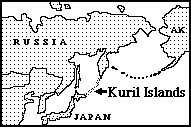
Spider Collector's Journal (7th page: Kuril 1996) © 2005 by Rod Crawford
As explained on the first page, most of these notes of fun (and not so fun) trips to collect spiders for research at the Burke Museum appeared in Scarabogram, newsletter of "Scarabs: The Bug Society," in their original forms. References to the editor mean me. Dates head each paragraph. Color Russian topographic maps have a black square 4 km grid for scale; contour interval is 40 m. RETURN TO INDEX
What I Did This Summer
(The 1996 Kuril Islands Expedition)
 |
Having participated in the first (1994) expedition, I "rested" in 1995 while Vince Roth, on what was to be his last major expedition, collected the spiders of the south-central Kuril Islands. Among his discoveries was a very cool intertidal hahniid spider, new to science! In 1996, I again joined the crew (now enhanced with more Americans and a Japanese team) for the study of the north-central islands. If my narrative seems to harp on negative aspects, it's only that those are the most interesting parts; I did have a good time. All thanks to Professor Ted Pietsch for organizing and obtaining funding for the International Kuril Islands Project (IKIP), and to the National Science Foundation for funding it!
25 VII 1996: The American contingent meeting at Sea-Tac Airport included Ted, Brian, Andres, Noboru and me from 1994, plus ace botanist Sarah Gage, one student each from Mexico, Sweden and Germany, and our new malacologist Tim Pearce (then of the Delaware Natural History Museum, now at the Carnegie Museum in Pittsburgh). Our flight this year was via the Russian airline Aeroflot. They handled our voluminous baggage and supplies flawlessly, but the trip did feature one adventure. In Magadan, Siberia we were told there was fog at our destination, so we had to spend the night on hard wooden benches at Magadan airport. It was rumored or suspected that the plane's crew had family in the city... since on arrival at Vladivostok, our friends said "what fog?" Since we were a day late, we set sail almost instantly (which is why you got no postcards from me!) in a larger than usual ship, the Akademik Oparin (248 ft. long, 48 ft. wide, displacement 2600 tons, speed 15 knots, crew 43). It seems the good old Bogorov was in dry-dock. More luxurious in some ways, the Oparin's labs were designed for marine chemistry, making biological work somewhat awkward. Also a bigger ship means longer rides to shore. But at least we had motorized rubber landing craft, which even worked most of the time! The Russian team was the same as in 1994, but with another lovely lady added, botany student Marina Ilyushko. Also with us were five biologists from Japan including ground-spider specialist Takahide Kamura and coleopterist Masahiro Ohara.
 |
| North Kuril Islands Red = sampled in 1996 Ushishir is at latitude of Seattle |
In a few days, the team was at Paramushir (see map, right) in the North Kuril Islands, ready to start raking in specimens in our specialties: botany, meadow insects, aquatic insects, bees, beetles, spider wasps, mollusks, fish, and spiders! Most of the islands visited this year have no forests. Tree species exist, including one each of alder, pine, and yew, but individual trees are shorter than a man, and exist in small thickets rather than large stands, interspersed with various kinds of meadow, wetland, and dune communities. Beach habitats were always available; rocky uplands, which could have added many species, existed on most islands but were usually unreachable from the beach in the time available.
1 VIII 1996: We landed at Severo-Kurilsk, Paramushir (largest of the North Kurils), to "check in" with local authorities, and collected while there even though not on this year's agenda. Paramushir has real mountains, with all kinds of cool upland terrain promising great spider diversity. And Viktor managed to wangle transportation from the local army base. At least 20 of us played sardines on benches in the back of a small Russian Army truck, jolting over a jeep trail en route to a collecting site selected (as usual) by Higher Authority without consulting the collectors. Brian was heard to yell "Don't you wish everyone used Sure?" So, over a rocky ridge we go and right back down to sea level and a "typical Bogatov lake," elevation 5 meters! Some good spiders were taken nonetheless, from alder thicket litter, meadow foliage, Sphagnum, beach rocks, and in the open. The wolf spider Pardosa atrata and a new microspider in an undescribed genus, closely related to one found in Washington, were the best specimens.
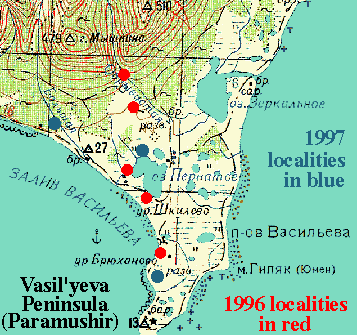 |
3 VIII 1996: On our way south, we made one more stop on Paramushir. You can guess, can't you, that it was far out on a long, near-sea-level dune peninsula reaching south from the mountainous part of the island, with plenty of interdune lakes! But spider-men never say die. By dint of a long, long hike, Eskov, Kamura and I reached 80 m elevation on the Obryvistaya (steep) River, where we got a fine, diverse collection from foliage, Sphagnum and litter. Five microspider species not found elsewhere were sifted from one small Sphagnum patch inside an alder thicket. On our way back to the boat (bottom red dot on map), I got my first taste of collecting from the thickets of dwarf Pinus pumila, which often had excellent spider diversity in both the foliage and litter. We found a different Sphagnum habitat on the low-lying shore of Pernatoye (feathery) Lake. Also strawberries!
 |
4-7, 9 VIII 1996: Onekotan, largest island on this year's schedule, got a relatively good going over. On the 4th, at Nemo Bay (named for the Jules Verne character), the wind almost blew us out of a canyon. Retreating back down to the Nemo River flood plain, I got an unexpectedly big collection from loose, spongy moss on a river island but not much in other habitats. If we thought this wind was bad, weather on the 5th at Cape Subbotyna (Saturday) combined even higher winds with sometimes-torrential rain (starting after we were on shore and couldn't turn back). Only a big bag of moss brought back to the ship to sort saved yr editor from being skunked. However, the best species of the day was among the 10 specimens under rocks.
After an idle day (sunshine! but unable to land due to "very biggest waves") we had our biggest day on Onekotan at Mussel Bay on the Pacific side. Some decent collecting on a low plateau was followed by huge numbers of specimens under scrap metal and boards at an abandoned army base. Meanwhile, others hiked clear up to the 600-m elevation rim of the crater lake, but only got a few spiders in the short time available. Finally, on the 9th we returned to Onekotan for the last time near the Trudnyi (difficult) River, unluckily landing at the base of a slope so steep that no one got very far inland. Also unlucky was yr editor's leaving one of the expedition GPS units behind on the beach! However, the steep grass-herb meadow had a good array of foliage spiders, better sweeping than we'd had up to now, including interesting crab spiders.
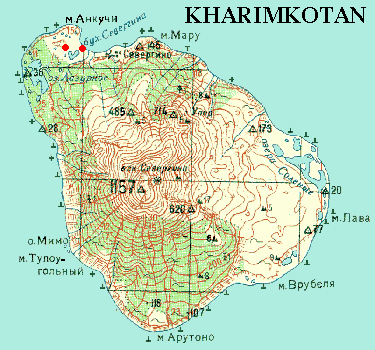 |
8 VIII 1996: Our one day on Kharimkotan, an island with a giant lava flow on the east side, potentially with many caves to explore for cave fauna. Alas for dashed hopes! We landed on the northwest corner, just too far from the lava for practical access. Perhaps the Pacific surf had something to do with it, but isn't it funny that we ended up in a place with interdune lakes! The vegetated foredune produced lots of spider specimens from alder litter and under driftwood, as well as 20 active wolf spiders, but only 2 of the 21 spider species are especially interesting. One of these, though, is the most amazing spider record of the trip (also found on other islands): Sisicottus panopeus, common at treeline in the Washington Cascades, which represents a genus heretofore unknown in the Old World!
10 VIII 1996: A three-island day, but no landing for me. First on the agenda was Lovushki Rocks, home of one of the few remaining large fur-seal colonies. Aggressive seals prevented landing. (We did land the following year, and got one spider species.) Chirinkotan is one of those bird-rookery "table rocks." Since I'm no rock climber, I resigned my place on the small shore party to someone else. A few spider species were taken here, amid birds that would throw up at you if you approached too close! The third island, Ekarma, would have retrieved my fallen fortunes but due to a weird communication snafu I didn't even know we were there!
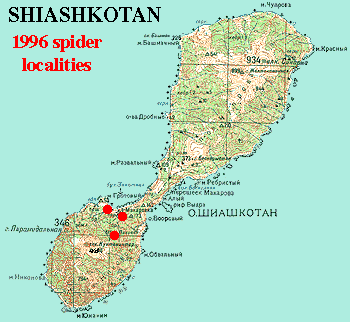 |
11-12 VIII 1996: Shiashkotan is a fair-sized meadowy island consisting of 2 volcanos connected by a narrow neck, and deserved far more than one short day's visit. There being no lakes, we landed at Zakatnaya (sunset) Bay, where spider collecting was done from the beach, a ravine, and switchbacking up the bluff via an old trail to a grassy plateau that featured fascinating remains of an Ainu village. Pontus Oberg (Swedish student), bless his heart, climbed 515-meter Mt. Pakovaya, a parasitic cone of Kuntomintar Volcano. Only 2 or 3 spiders were taken in his half-hour at the top, but they were the expedition's only high-altitude sample and included the quite rare wolf spider Pardosa paramushirensis. Then we were called back to the ship in midafternoon. What was the emergency? The need, by golly, to prepare for a birthday party, which the guest of honor didn't even want! The gods punished us for this hubris by washing out our second day on Shiashkotan in a downpour of rain.
13 VIII 1996: Raikoke is quite a small (less than 2.5 km), round volcanic cone rising straight out of the sea. Unlike some other Kuril volcanos, the sides of this one are very cindery, making it the most barren island we'd landed on yet. Our first landing was at a small cove from which rock-climbing would be needed to get any higher up. But I still got some spiders under rocks and among the Angelica (the one plant growing out of the bird guano). Another, more difficult landing spot was found later from which some of us got onto the higher slopes. An unpromising spot, but it produced 21 species in half a day. One of the commonest spiders here was a new species of Oreoneta which, as I write, has just been described and named.
14-15 VIII 1996: Middle-sized Matua proved a very interesting island. The most northerly Kuril island with "forests," some of the alder trees being all of 10 feet high, several of the common spiders of the Southern Kurils appeared here for the first time...and already common. Evidently they could have survived farther north as far as the climate goes, but not without a tree canopy. A rainy first day was ameliorated because the soldiers of the small army garrison kindly allowed me to take over an unused building to sift leaf litter in. Continuing most of the day produced 215 spiders, though only 10 species. Several others were found under wood and scrap metal. On the second day we hiked across the island, finding that on the other side (with no obvious topographic barrier) it was treeless and foggy with bone-chilling wind, while it remained balmy on the forested side. Strange are the ways of weather! Sifting Sphagnum and sweeping a grassy meadow yielded around 15 additional species. I'm sure the island has lots more.
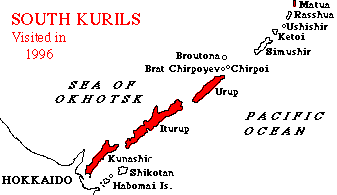 |
18-19 VIII 1996: Well, here we were back at Konservnaya Bay on Iturup in the Southern Kurils to stock up on much needed fresh water. The early cutoff of North Kurils cruising was blamed on too many American showers (but we know who really took the long showers). Here, it was a challenge to find new spider habitats not sampled last time, but lots of specimens were taken, the most interesting being the odd little orbweaver Theridiosoma. Some wolf spiders not taken here before were found among the grass-covered ruins of the old cannery. Overnight light-trapping yielded many moths. Eskov climbed a cliff to the plateau above, then lost a hard-won vial of spiders through a hole in his pocket! On our way south to Iturup, we attempted to land on Brat Chirpoyev but couldn't due to surf. It was skipped in 1995 for the same reason. Had I but known!
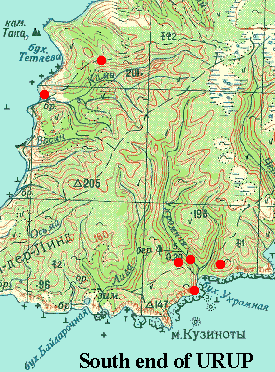 |
20-21 VIII 1996: Ukromnaya (secluded) Bay on the Pacific shore of Urup in the Central Kurils. Yr editor's first time on this big island, said to be the only one in the group that has blackflies. Does it ever!! We were constantly surrounded by clouds of them, even on high hillsides (it's a terrestrial species that doesn't depend on water to breed), only slightly affected by repellent. I blessed my foresight in bringing a head net, allowing me to laugh at the little devils...oops! forgot about my left hand. Out with the surgical glove! Perhaps because of the abundant prey, spider collecting was excellent, though climbing hills against dense bamboo is a bit of a pain. Both sifting and sweeping in open alder woodland on hillsides and the river valley were very productive. My colleagues got other excellent spiders under flat rocks on the opposite hilltop, and we all shared a stony debris pile on the beach while waiting for pickup. Next day, at Tetyayeva Bay on the other side of Urup, it was back to normal North Kurils weather, a wind you could lean into which (looking on the bright side) blew the blackflies away. Most fortunately, I found a sheltered pocket and got a nice spider collection from alder and pine litter (both mixed with bamboo) by the time it started to rain in earnest. On the long boat trip back to the ship, water hit us from all sides.
22-23 VIII 1996: Another two days at an already familiar site, the north shore of Dobroye Nachalo Bay (map, previous page), so Viktor could look for more specimens of a new freshwater mussel found in '94. On the first day, I did a more intensive sample of riparian habitats around Lake Natasha, finding an interesting little crab spider (among others) in the swamp forest understory. A Malaise trap here oddly attracted lots of sac spiders, Clubiona riparia, overnight. I spent the second day cave-hunting on the Atsonupuri lava, but only found one small one. It had some of the same spider species as the other cave found in '94.
25-26 VIII 1996: On our way south, we spent two more days collecting on Kunashir (see map), the most floristically rich Kuril island (it even has magnolias!) which well deserves the extra sampling. On the 25th, the fish people revisited a hot spring (near sea level, naturally) housing a new species of goby. Most fortunately for me, the trailhead for the spring is an upland site (180 m) which produced my best spider sample of the whole expedition, around 40 species and 332 specimens from bamboo meadow, birch litter, fir and spruce foliage, moss, and 2 surface active wolf spiders. Included were several species (two of them new) and sexes of other species not taken elsewhere, such as my only male of the pretty ground spider Kishidaia. On the second day, instead of all the places never visited on Kunashir, the expedition headed (of course) for Lake Aliger, adequately sampled in 1994. I was dropped off at a low elevation Sphagnum bog that proved relatively barren, but the fir trees and roadside flowers were productive.
And so we said farewell to the Kuril Islands for another year. In all, parts of 21 days had been spent collecting on 11 islands, with my full-time efforts and part-time help by several American colleagues yielding 6682 spider specimens (a good average for sheer numbers), but fewer species than previous years. The various northern islands yielded 14-58 species each, only a minority of the species probably present but still far less than comparable effort yields on islands with some forest cover. And let us not forget the Limerick of the Expedition:
There was a professor named Pietsch.
The women all thought he was rietsch.
When they found he was poor,
They eyed him no more.
He ended up dead in a dietsch.
27 VIII 1996: In a doomed effort to clean off Toxicodendron toxins, my beating net was lost overboard! Luckily, collecting was over. On 30 August, we traveled by train some 30 km from Vladivostok to visit the insect collections at the Institute of Biology and Pedology, courtesy of Dr. Arkady Lelej, chief curator and my lab partner for the last 40 days. Train fare: 2400 rubles ($0.46). No spider collection to speak of, but I talked with orthopterist Storozhenko about his work on grylloblattids, and examined the historic Kurentsov butterfly collection, taking down some data for former-scarab Pelham.
2 IX 1996: We got our specimens out of the country by changing "specimens" to "samples" on a ream of forms!! And there were still 2 nice cats living in the air terminal building.
This page last updated 7 April, 2024